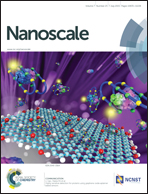Fabrication of bimetallic Cu/Au nanotubes and their sensitive, selective, reproducible and reusable electrochemical sensing of glucose†
Abstract
Herein, we report a facile two-step approach to produce gold-incorporated copper (Cu/Au) nanostructures through controlled disproportionation of the Cu+–oleylamine complex at 220 °C to form copper nanowires and the subsequent reaction with Au3+ at different temperatures of 140, 220 and 300 °C. In comparison with copper nanowires, these bimetallic Cu/Au nanostructures exhibit their synergistic effect to greatly enhance glucose oxidation. Among them, the shape-controlled Cu/Au nanotubes prepared at 140 °C show the highest electrocatalytic activity for non-enzymatic glucose sensing in alkaline solution. In addition to high sensitivity and fast response, the Cu/Au nanotubes possess high selectivity against interferences from other potential interfering species and excellent reproducibility with long-term stability. By introducing gold into copper nanostructures at a low level of 3, 1 and 0.1 mol% relative to the initial copper precursor, a significant electrocatalytic enhancement of the resulting bimetallic Cu/Au nanostructures starts to occur at 1 mol%. Overall, the present fabrication of stable Cu/Au nanostructures offers a promising low-cost platform for sensitive, selective, reproducible and reusable electrochemical sensing of glucose.


 Please wait while we load your content...
Please wait while we load your content...